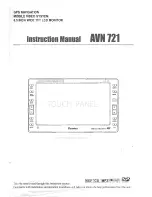Page 11 of 24
P/N 595278-01 Rev B 2/18
WARNING
FOLLOW THE REGULAR OPERATIONAL IN-
SPECTION PROCEDURE EXACTLY. IF THE
PAK-TRACKER LOCATOR SYSTEM DOES NOT AC-
TUATE, OR DOES NOT OPERATE AS DESCRIBED
OR IF ANY OTHER OPERATIONAL MALFUNCTION
IS NOTED, DO NOT USE THE EQUIPMENT. FAILURE
TO PROPERLY IDENTIFY MALFUNCTIONS AND
TAKE APPROPRIATE CORRECTIVE ACTIONS MAY
RESULT IN SERIOUS INJURY OR DEATH.
PAK-ALERT DISTRESS ALARM INSPECTION
Refer to the user instructions provided with the SCOTT PAK-ALERT distress
alarm equipped with the PAK-TRACKER Locator System for details about the
regular operational inspection.
HAND HELD RECEIVER INSPECTION
If any damage is found, remove the unit from service and tag for repair by
qualified personnel.
1. Visually inspect all Hand Held Receiver enclosure, battery compartment
cover, and display for cracks or other damage.
2. Check the optional Hand Held Receiver strap handle for weakness.
3. Verify that all fasteners and mounting hardware are present and tight.
4. Check all battery contacts. The contacts must be clean and straight.
5. Verify that a fully charged battery is properly installed. Refer to the
BATTERY CHARGING, INSTALLATION, AND REPLACEMENT section
of this instruction.
6. Turn on the Hand Held Receiver by pressing both the SELECT and SCROLL
buttons simultaneously. Verify that the unit powers up and all lights and
displays operate properly.
7. Battery Life – When the battery in the Hand Held Receiver has approximately
twenty percent (20%) of its life remaining, the “Low Batt” indicator light will
glow yellow. If the “Low Batt” indicator lights at any time during the regular
operational inspection, replace the battery pack with a fully charged battery
pack before proceeding with the inspection. See the BATTERY CHARGING,
INSTALLATION, AND REPLACEMENT section of this instruction.
After the “Low Batt” indicator light appears, the Hand Held Receiver will
operate for approximately forty-five (45) minutes. If the battery is not
changed in that time, the Hand Held Receiver will shut down and will not
operate until a fully charged battery is installed.
WARNING
THE PROPER OPERATION OF THE LOCATOR SYS-
TEM CANNOT BE CHECKED WITHOUT CHECKING
ALL COMPONENTS OF THE SYSTEM TOGETHER.
THE REGULAR OPERATIONAL INSPECTION MUST
INCLUDE THE HAND HELD RECEIVER AND THE
TRANSMITTER WORKING WITH EACH OTHER
TO CONFIRM PROPER OPERATION. FAILURE TO
PROPERLY INSPECT THE COMPLETE SYSTEM
MAY RESULT IN FAILURE OF ONE COMPONENT,
WHICH COULD LEAD TO SERIOUS INJURY OR
DEATH.
WARNING
THE SENSITIVITY RANGE OF THE HAND HELD
RECEIVER MAY DIMINISH WITH DECLINING BAT-
TERY LIFE. ALWAYS USE A FRESHLY CHARGED
BATTERY WHEN INITIATING A SEARCH TO EN-
SURE MAXIMUM BATTERY DURATION. USE OF A
HAND HELD RECEIVER WITH REDUCED BATTERY
LIFE MAY JEOPARDIZE THE SUCCESS OF THE
SEARCH, WHICH COULD RESULT IN SERIOUS
INJURY OR DEATH.
REGULAR OPERATIONAL INSPECTION
Inspect and test the Scott Safety PAK-TRACKER Locator System before
each use. If any malfunction of the PAK-TRACKER Locator System is noted
during the inspection, remove the equipment from service and tag for return
to the manufacturer for repair or replacement.
NOTE
IF THIS INSPECTION IS DONE IN DIRECT SUNLIGHT, IT MAY BE HELPFUL
TO SHADE THE DISPLAY ON THE HAND HELD RECEIVER WITH YOUR
HAND TO BE SURE THE LIGHTS ARE FLASHING AS DESCRIBED.
WARNING
IF THE LOW BATTERY INDICATION OCCURS AT
ANY TIME DURING REGULAR OPERATIONAL
INSPECTION, DO NOT USE THE EQUIPMENT.
CHANGE THE BATTERIES AS REQUIRED IMMEDI-
ATELY AND REPEAT THE REGULAR OPERATIONAL
TEST OR TAKE THE EQUIPMENT OUT OF SERVICE
UNTIL THE BATTERIES ARE CHANGED AND THE
REGULAR OPERATIONAL TEST IS SUCCESS-
FULLY PERFORMED.


















